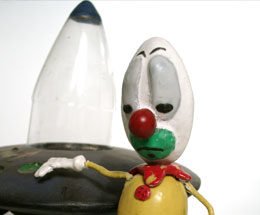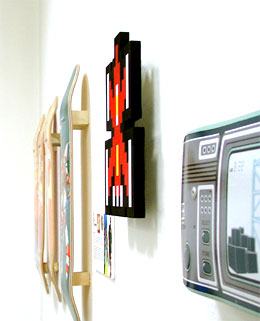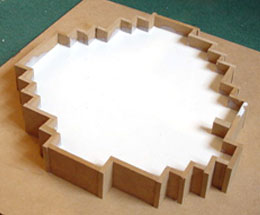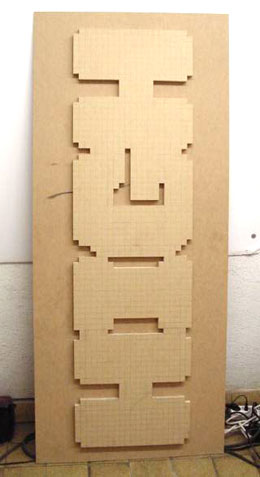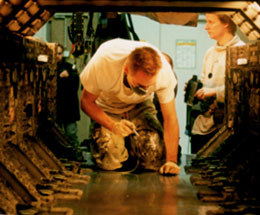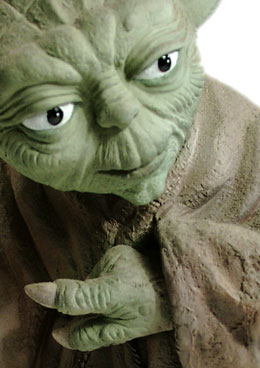 |
 |
|||||
| >> faux_heimat >>faux_kultur | |||
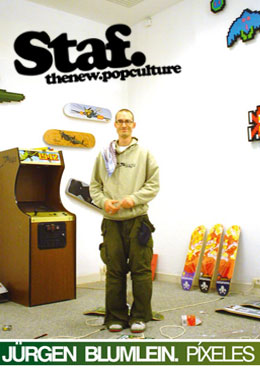 |
FauxAmi Interview Im Jahr 2001 war er Mitbegründer der Künstlerverbindung FauxAmi und arbeitet als 2d Flame Artist und freier Künstler in Stuttgart und Berlin. Er hat 2003 sein Diplom an der Filmakademie Baden-Württemberg im Bereich Digitale-Bildgestalltung erhalten. Im Dezember 2003 organisierte er zusammen mit FauxAmi die erste “SKATEBOARDFIEBER” Ausstellung in Stuttgart. Danach zog es ihn nach München, wo er an Bully´s Kinofilm “(T)raumschiff Surprise” an den Visuellen Effekten mitwirkte.Im Herbst 2004 folgte darauf die Ausstellung "SKATEBOARDFIEBER" - BERLIN. Zur Zeit lebt und Arbeitet er in Berlin als Digital Artist. Wer gerne das Interview in spanisch lesen möchte kann sich hier das Interview als PDF herunter laden: oder am Ende des englishen Interviews online lesen. |
|||
|
Hi Jürgen, how're you feeling today? Very good! It's not raining right now in Berlin and I have a kind of summer feelings. I'm looking forward to great weekend with my girlfriend. All right, I just hope I don't screw it up with my questions hehe. We will see... So, having a quick read on your bio lines is enough to get a little bit confused... Skater, computer freak, digital artist, moviemaker, sculptor, graphic designer... Man what the hell are you?? Well I'm 32 years old now. So I had a lot of lifetime to do and learn different things. Now I may sound like a plus student, but I totally screwed up in school.I'm more the practical guy. I love to do things by hand.With 10 I saw "Star Wars" and it changed my life or gave me a clear direction. I became a movie maniac and my special interest became for the visual effects in particular. At that time most effects in movies were done with miniatures and models. So I started to build plastic models and read everything about movie making. In the eighties the VFX industry started to use computer technologies, but my first contact and interests in the digital world was more for playing games.Pong and Atari later the C64 and really early PC´s, which my father brought, home at weekends from IBM were he worked. And of course the arcade machines. But I never became a totally nerd. Thanks god before that happened a friend of mine came one day with a plastic 70´s skateboard. |
|||
|
Yeah, okay... But which of those things would you say you do best? I think it's hard to say I'm do best at... It always sounds stuck up. Or you compare to others like in competitions what means there just winners and losers. So the best is to do what you want to do and you will give your best.As I started my studies, I had less and less time for skating. So I think my skateboarding is more the early nineties style. It's still a very important part of my life and a means lot of fun to me, but I think most 12 years old youngsters are much better for sure.Today I work as a digital-artist for feature films and commercials and I think I do best, and sometime I love what I do and sometime its sucks. Sitting all day and spending hours in front of a computer screens feels sometimes not real, so I started working with my hands again and it does best to me. |
|||
|
Mmm. The thing is that I actually forgot one thing... Museum curator, right? Cause that's kind of the thing you do for Skateboardfieber, right? Tell us a little bit about it, cause you know it's hitting Spain soon! You were involved in the project from the beginning? How did you came up with the exhibition concept? How's been the process? As in the early nineties one cared for the obsolete shaped skateboards in the shop anymore. So I get them really cheap. I bought a couple and I think back I spent nearly all my earning in the skate shop for skate stuff. Years later I displayed them at the walls of my flat. At my first solo art show I thought about to display some boards next to the pixel-skater but the curator didn't like that idea. One day Daniel (Schmid the other curator of the Museum) and me were talking about how every skater has still a lot of stuff under their beds and in the cellar. So it all started. The idea of a skateboard exhibition was born.We collected stuff for over a year and tried really hard to find a location for it. But that was harder then we thought. Skateboarding, culture, art... the most people didn't get that together. One day we met a guy from the city council and he was really open to our idea and he even had a location for us. We had the first exhibition running for two weeks in 2003 and it was such a big success with the public that we could keep the space. (Well in a way we occupied it, cause we didn't cleared up the exhibit, but the guy from the city was really cool with that). So it came to the museum. We got a lot of mails all over Germany to show the exhibition some were else and last year we showed the exhibition in Berlin the German capital city. There we had a lot more space like in Stuttgart were the museum is based and could even build an indoor ramp in the exhibition. We like the idea of traveling around with the exhibition. So this October we will be in Barcelona for two weeks (thanks to you guys from Staf!) and this time the focus will be on artwork by skaters. So stay tuned! |
|||
|
Some of your PixelPlastiken are featured on SkateboardFever... And they're cool mate! I mean, it's nice to see how you happened to turn some kind of fashion trend into something new by approaching it from a different angle. How did you come up with that? Thx for the compliment. How I said I thought about to display skateboards next to the pixels, so now its twisted and I (now I'm the curator...Hehe) love to display one or two of my works at the Skateboardfever exhibits. We try to focus more at the art side of skateboarding and try to display more artworks from skaters and friends.And how it came up to me. Well it's a mixture from a lot of things. In the early Macintosh system you could pimp your desk with several themes and wonderful little icons and in my daily work I really often zoom into the images, until they are just pixels. Pixel is the term for picture element, the smallest part of a digital image. So I think I became a Pixel-lover (screw splines!)On the other hand I did a lot of models and miniatures at my studies so I still had a lot of paint and other materials. And one day I had the idea to build three dimensionally pixel icons and display them on my wall. Also, tell us a bit about the handcrafting process, cause it looks like fine ended and stuff. I mean, seems like you know how to use your hands, don't you? The first Pixelpalstic were cut out of Styrofoam, later a friend of mine ( Angel, an artist from FauxAmi as well ) came with the idea to cut them out of wood. So now I do make a negative out of the wooden positive with silicon. After that process I fill resin (liquid plastic in the form and get back a plastic positive of the Icon. Then I mix the colors and spray each pixel after pixel, till I have a finished one. It takes days from the beginning to the final PixelPlastic. And each one is one of a kind.All that years as a model maker I learned to work with the airbrush. As I started to build models for films I get in contact with special materials like resin and silicon.
|
|||
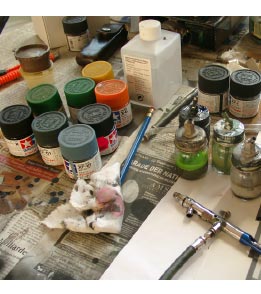 |
I read around that you are making just 10 pieces of each model. So you sell them, right? Mmm. That leads me directly to the typical question Art Versus Money... What's your point on that? Well the limitation of the Pixels is a result of the work process and not to make them a very rare super special limited what ever...When you mix the two components of resin, a chemical reaction starts that produces a lot of heat, which destroys the silicon negative. It's getting dryer and loses more and more flexibility. So I just can use the form for 10 times until it's completely broken. And of course I don't want to make to many of the same one.So there will be always new styles. Right now my focus is on the 80tis arcade games.And well art versus money. I think I could write two pages about that but I will try to make it quick. So how I said the materials are really expensive and I spent a lot of time for one Pixel, so hey ok the cost money, like ever good that is produced. But you will get a nice colorful artwork for your home wall and you will get a real personal part of me. And I will never force anyone to buy my art. Feel free or watch them for free, cause when we do exhibits, the entrance is always free for the people! |
|||
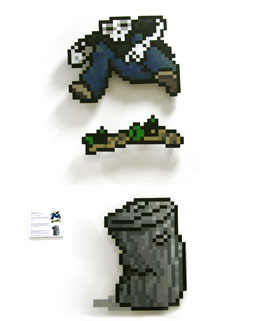 |
And how is it going so far? Do you thing you'll get a life with this? Hey, or maybe you already do... Uh? I still have my job in the postproduction industry. And I like my work a lot. Sometimes I wish I would have more time for my artwork and for the museum.But hey it works both together. I work for my living and once in the year I took a time out do an exhibition. My job gives me a lot of freedom and normally I try to make a PixelPlastic for people how want one, really fast, but it takes time. I started three years ago with my art and the people still like it. So do I, and when I can make out a living one day it will be cool, but that would never be the motivation to do it. I have to love what I do and money should not be the reason or motivation. Then what's up with the movie making? You didn't give that up, uh? Any projects for the future in this matter? I did some short films and animation movies before I studied at the film school. Of course we had to shoot some more at the school, but I had and have my focus on the visual effects side. And they are a really important today to get the vision of the director on the screen. |
|||
And skateboarding? You still ride the board everyday? Well I would like to ride any day, but Berlin is not the best city for skateboarding. We have really bad surface here and we had a very rainy summer this year.But every minute on my board makes me smile...so I'm looking forward to October in Barcelona. Three weeks skateboarding! Actually I just didn't forget one thing, I did two: the FauxAmi thing. How long has that been working? How did it start? At my first solo exhibition in 2002, all my good friends came together from all over Germany. We talked all about our future plans and thoughts, and we recognized that we would see and meet less and less. We all work with computer and so we decided to build up a point in the WWW were we all could meet and have a space for thought and projects. So FauxAmi was born. FauxAmi is French and is translated "fake friend". I don't speak French, but one day I was searching for a word in a dictionary of foreign words and saw "FauxAmi" and I really liked it.So we came to the name, and we really like cause we still know our real friends.More and more friends are joining us and we have a worldwide community now.And since we have a "blogger" start page and a lot of interesting interviews and reports from exhibitions and travel reports, every month more and more people visit us online. So check out www.FauxAmi.com for free too! We even try to do some articles in English and Espanola.
|
||||
|
Yeah, that should be satisfying. Putting out other artist's works. Tell us about the artists in FauxAmi that have surprised you the most. Well we are a colorful group. We feature photographers, graphic designer, silk screener, free artist and directors and and and. Well last summer Daniel and I met Jeremy Fish at an art show in Zurich and we had a great time and stay in contact since this time. In May this year we were in the States and he offered us to stay in his flat and he introduced us to his friends he and showed us cool places. He is a really cool guy and a great artist. So we are really happy to have an interview with him on the FauxAmi page and to invite him here to Spain for the Skateboardfever exhibition in Barcelona. The same with Stefan Marx. Last year he painted a wonderful artwork on our miniramp in Berlin. He will be in Barcelona too! So check out the artist we feature! Don't forget to mention Andy "New Deal" Howell! But hey, if we talk about satisfaction... is there anything better than a couple of hours with the playstation?? Hehe I'm more the Old School type of gamer and love to play old coin ups arcade machines. You can get them on eBay for good price. But you need more space for the machine then for the ps. My all time favorite is 1942! An arcade classic witch I honored once as an installation. So lets play... Thanks for the time mate. Take care. Curro Oñate. STAF MAGAZINE. --------------------------------------------------------- More about PixelPlastic you will find here: |
|||
|
Jürgen Blumlein Píxeles de plástico Jürgen es el típico culo inquieto. Tiene 32 años y es una suerte de artista digital, escultor, técnico de efectos especiales, amante del cine, freak de los videojuegos y, por supuesto, skater. Una mezcla muy de nuestro tiempo que, en su caso, ha acabado tomando forma propia: PixelPlastic. La imaginativa y personal forma que Mr. Blumlein tiene de interpretar un simple código binario. Bienvenidos al oldschool digital. Algunos de tus PixelPastic han sido expuestos en la ya mítica exposición alemana SkateboardFever, de la que tú eres co-organizaor... Y la verdad es que molan un huevo. Lo que me parece sorprendente es como le has dado la vuelta al rollo píxel, que está bastante trillado ya, abordándolo desde un ángulo diferente. ¿Cómo surgió la idea? Vaya, gracias por el cumplido. Los PixelPlastic son la mezcla de un montón de cosas. En los antiguos Macintosh el entorno gráfico estaba plagado de maravillosos y diminutos iconos hechos a píxel, un elemento con el que estoy muy familiarizado, ya que en mi trabajo diario suelo manejar las imágenes tan de cerca que son sólo eso, píxeles. La palabra píxel viene de "picture element", y es el elemento base con el que se forma una imagen digital, y por tanto su parte más pequeña. Lo cierto es que con el tiempo me he ido convirtiendo en un amante de los píxeles. Pero, por otro lado, he hecho muchos modelos y maquetas a escala por mis estudios de efectos especiales, por lo que aún tengo montones de latas de pintura y otros materiales por ahí. Y simplemente un día se me ocurrió la idea de construir iconos con píxeles de tres dimensiones para colgarlos en mi pared.
Los primeros PixelPlastic estaban hechos con cartón pluma. Más adelante, un amigo mío, Angel, me propuso hacerlos en madera. Y ahora lo he complicado todo un poco más. Primero hago la forma en madera, y partiendo de ella saco el negativo con silicona. Después, relleno el negativo con resina (plástico líquido) y así obtengo la figura final en plástico. Entonces mezclo los colores y doy el tono con spray en cada píxel hasta que está acabado. Cada pieza me lleva días.Todos aquellos años que pasé modelando me permitieron aprender a usar el aerógrafo, y otras muchas técnicas. La experimentación con materiales como la resina o la silicona se la debo a los montones de maquetas para películas que construí en el pasado. He leído por ahí que sólo haces diez piezas de cada modelo. Osea que las vendes, ¿no? Mmm. Eso me lleva directamente a la típica disyuntiva Arte vs. Dinero... ¿Cuál es tu opinión al respecto? Hombre, la limitación a diez piezas por modelo es resultado del proceso de producción, y de mi intención de no hacer algo en plan edición superlimitada. Cuando mezclas los dos componentes que forman la resina se crea una reacción química que resulta en temperaturas muy altas que acaban por destruir el negativo de silicona. Se va secando y pierde cada vez más flexibilidad. Por eso sólo puedo usar los negativos diez veces hasta que terminan rompiéndose. Y, por supuesto, tampoco quiero hacer demasiados del mismo modelo. Eso garantiza que siempre habrá diseños nuevos. Por ejemplo, ahora me inspiro mucho en los videojuegos de los ochenta. Y respecto a lo del Arte vs. Dinero... Creo que podría estar horas hablando de esto, pero intentaré ser breve. El hecho es que los materiales que utilizo son muy caros y además la realización de cada pieza me lleva mucho tiempo. Así que sí, valen dinero, como producto que es. Pero lo que te llevas a cambio es una bonita y colorida pieza de arte para tu pared, y una parte de mi persona. Ahora, en ningún caso obligo a nadie a pagar nada. La entrada a mis exposiciones siempre es gratuita, para que todo el que quiera pueda mirar.
Todavía conservo mi trabajo en la industria de la postproducción digital de imagen, y es algo que me encanta. Aunque a veces me gustaría tener más tiempo para mi arte y para el museo (SkateboardFever). Pero la verdad es que al final se puede combinar todo. Trabajo para ganarme la vida y una vez al año saco algo de tiempo para hacer una exposición. Empecé a dedicarme al arte hace unos tres años, y parece que a la gente aún le gusta. Y la verdad es que a mí también, así que si algún día puedo ganarme la vida con ello estaré encantado. Pero mi motivación para hacerlo nunca será esa. Mi motivación para hacerlo es el amor que siento por ello, no el dinero.
Allá por el 2002, cuando hice mi primera exposición en solitario, mis amigos vinieron de toda Alemania para estar conmigo. Hablamos de nuestras ideas y planes para el futuro, y empezamos a darnos cuenta de que cada vez nos veríamos menos. Todos trabajamos con ordenadores, así que decidimos montar algo en internet para seguir en contacto y tener un espacio para nuestras opiniones y nuestros proyectos. Así nació FauxAmi. El nombre viene del francés "falso amigo". Yo no hablo francés, pero un día buscando una palabra en un diccionario multilingüe ví FauxAmi y me gustó mucho. Desde entonces se ha ido uniendo mucha gente nueva hasta la comunidad internacional que somos ahora. Tenemos una especie de blog en la home, un montón de entrevistas interesantes y reseñas de esposiciones y viajes por todo el mundo. Cada vez nos visita más gente, así que no dudéis en pasaros y echar un vistazo en www.FauxAmi.com. Entrevista_ Curro Oñate by Curro Oñate 2005 for Staf Magazine Fotos_ Fauxami.com More about PixelPlastic you will find here:
|
|||
| --------------------------------------------------------- |
||||
FauxAmi ist nicht verantwortlich für die Inhalte externer Internetseiten.
Diese Seite wurde erstellt von www.braitling.de
